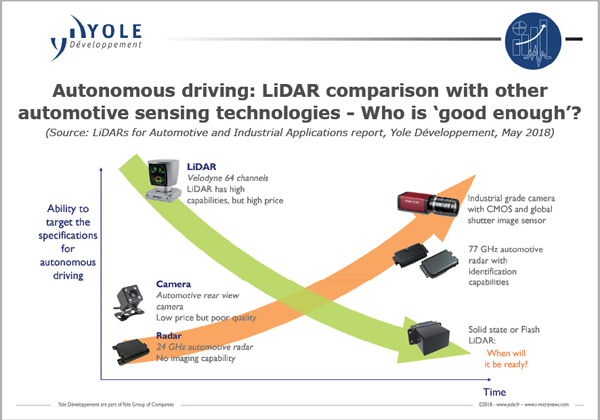By Aalyia Shaukat, contributing writer
Autonomous vehicles are a potentially life-saving technology and, if perfected, could drastically reduce the number of fatalities caused by operator error. The technology that these cars use to measure and interpret the world around them function in a variety of ways. Current autonomous vehicles rely mostly on an established technology known as light detection and ranging, or LiDAR.
Car accidents cause 1.3 million fatalities every year worldwide, and according to U.S. regulatory statistics, 94% of them are solely attributed to human error. Between 2014 and 2016, the number of automotive fatalities rose by a staggering 14% in the U.S., a rise that some analysts believe corresponds to increased cellphone use and distracted driving.

What is LiDAR?
LiDAR functions similarly to its preceding radar and sonar implementations by using lasers, but LiDAR sends out high-frequency pulses of light at wavelengths of about 830 nm to 940 nm and uses a mirror instead of an antenna to scan the laser. This light bounces back to a sensor, which interprets the signal and calculates the distance the light has traveled by measuring its diffusion. In this way, LiDAR systems enable autonomous vehicles to detect obstacles or other vehicles.
LiDAR technology is expected to advance rapidly over the next few years. According to Yole Developpement, the market for automotive LiDAR systems is expected to grow from $726 million in 2017 to an astounding $5 billion in 2023. This boom in the industry is being driven by a multitude of companies including Mitsubishi, Nissan, Toyota, and Denso. According to a report from Knowmade in January 2017, more than 30,000 inventions related to LiDAR have already been published.
The evolution in LiDAR technology for autonomous vehicles
LiDAR, however popular, is not the only autonomous vehicle guidance system in development at this time. A multitude of other technologies are being developed to augment LiDAR in the future. One such emerging technology is microelectromechanical system (MEMS) scanners. These MEMS mirrors are built on the foundation of previous LiDAR scanners but with a few advantages.
The new MEMS scanners are both smaller and cheaper than previous LiDAR and use only a fraction of the energy. They are also more accurate, using two lasers that scan on separate axes and reflect onto a mirror rather than using one wide laser. By using two axes, the MEMS systems can detect tiny movements faster than previous LiDAR and can give autonomous vehicles a faster reaction time.
Other companies such as XenomatiX and Continental propose a new kind of Flash LiDAR in which the entire area is illuminated at once rather than being scanned, reducing moving parts and driving down production costs. Other companies are attempting to advance LiDAR by increasing the power of the laser from 830 nm to the much more powerful 1,550 nm ― a feature that could provide better dust resistance and more accurate readings in unpredictable conditions such as rainstorms.
Pulsed or continuous-wave?
While pulsed-based direct LiDAR is advancing rapidly, other technologies have been created that function on a completely different principle. Continuous-wave ranging methods are being developed to allow for heterodyne detection, a process that detects tiny phase shifts in infrared light caused by motion. The phase-shift ranging method is being developed by companies IFM and Beneweke, while other companies like Oryx and Blackmore are exploring the frequency-modulated continuous-wave (FMCW) ranging method.
Developers of autonomous vehicles in the future will have a smorgasbord of options to choose from. “The IP landscape is dominated by tier ones and automotive OEMs players that have contributed to the development of LiDAR for ADAS applications [parking assistance, anti-collision alarms, etc.],” explained Dr. Paul Leclaire, IP analyst at Knowmade. “Among the top five patent assignees, four are Japanese — Denso, Mitsubishi, Nissan, and Toyota. The main Japanese players are automotive manufacturers.”
By using LiDAR with new modulation techniques and new hardware such as MEMS scanners, these new technologies could be used together to create safer and much more reliable autonomous vehicles for the future. We can expect to see a variety of these features coming into play in the years to come as developers continue to research and apply these technologies to the automotive industry.
With the growing demand for self-driving vehicles and many of these systems already deployed, this technology will likely proliferate. The future of travel will be automated and leveraging multiple technologies from millimeter-wave radar to LiDAR; the redundancies designed in these systems allow for a much safer travelling environment.
Advertisement
Learn more about Electronic Products Magazine





